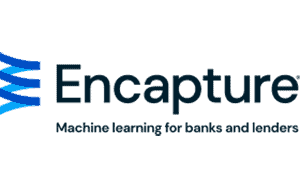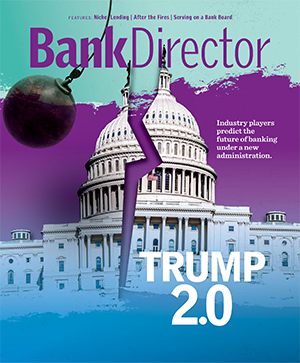Tyler Barron is the Chief Revenue Officer at Encapture, an intelligent automation platform providing banks with documentation efficiency. Using machine learning and AI technology, Encapture helps banks reduce compliance risks associated with fair lending guidelines, reduce overhead costs and improve profitability in a volatile market.

How Automation Can De-Risk Compliance
It’s time for banks to embrace innovative and long-term compliance solutions.
Brought to you by Encapture

*This article was published in Bank Director magazine’s second quarter 2024 issue.
Banks are struggling to meet new data reporting requirements and mitigate compliance risk in the face of skyrocketing costs and profit pressures. They also must respond to the hot topics of artificial intelligence (AI), automation and machine learning, or risk obsolescence.
The latest frontier for automation is regulatory compliance reporting. Automation platforms have emerged that can easily integrate with existing systems to help banks solve inefficiencies, redundancies and data quality issues caused by human error. This is fast becoming the new standard for compliance teams, and banks will need to respond.
Data Challenges
Accurate data collection and reporting is crucial for compliance. Banks must collect demographic data from mortgage borrowers under the Home Mortgage Disclosure Act (HMDA) and from small business borrowers as required by the recent Dodd-Frank Act 1071 rule.
Manual data scrubbing is time-consuming and costly. Data rarely stays holistically synced, while compliance and risk groups are often at the mercy of whatever data are entered into their systems. Inaccurately collected data can lead to fines, reputational damage or an inability to do deals.
Automating Compliance Risk
AI platforms that focus on streamlined automation systems ensure sufficient data quality by following a four-step process:
When documents are entered into business systems, the machine learning algorithm identifies the documents and extracts data fields for compliance requirements, like HMDA and Community Reinvestment Act fields.
The machine learning platform extracts and compares data points across source documents, banking systems and regulatory reports. Errors and data inconsistencies are flagged for human review.
A compliance officer double-checks the loan to determine if the discrepancy resulted from an error or some other documentable cause and corrects the highlighted data fields.
If requested, validated data fields are pushed back into the regulatory report or business system.
Automated learning algorithms efficiently collect data, compare reports and identify discrepancies for review. Machine learning also flags and corrects inconsistencies between data points before pushing them back into the system.
This automated process drastically reduces the time compliance teams must spend manually combing data for errors. An audit trail tracks data changes, which minimizes risk, while compliance teams can spend time on more value-added tasks.
Real-World Application
Over the years, dozens of institutions — including small and medium-sized banks — have integrated automation into existing networks, ensuring seamless communications between different systems and reducing labor costs.
Regional banks are uniquely positioned to confront compliance process challenges with automation platforms. For example, a bank with 300 branches across four states can use AI to help prioritize data integrity and streamline data collection for the 110 HMDA data fields. A well-regulated, comprehensive machine learning system can reduce the HMDA document validation processing times to less than five minutes, all with increased data integrity and significant cost savings.
Banks also can use automation to streamline other compliance tasks, such as CRA reviews.
Ultimately, automation can increase bandwidth for banks while helping to improve borrower experience and staff productivity.
Why Now?
The need for automation sneaks up on many financial institutions. When banks reach that crucial $5 billion to $10 billion asset threshold, oversight gets more stringent and scrubbing data manually means higher staffing costs. Bank boards in that position begin to look for ways to increase compliance efficiency and turn to automated solutions.
Integrating automation into existing systems also can create the additional bandwidth needed to operationalize new regulations, such as 1071, and help mitigate burnout and turnover by freeing employees to focus on more rewarding work.
While some financial institutions hesitate to invest in machine learning, innovative compliance and risk leaders understand the need to do things differently in an increasingly complex regulatory environment. AI inarguably improves time and cost efficiency while mitigating risk and ensuring operational efficiency. It’s time for banks to embrace innovative and long-term compliance solutions.


